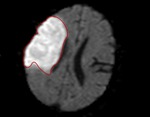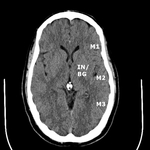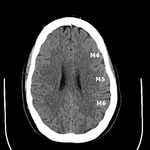Aims and objectives
As advancements are made in the treatment of acute infarcts,
it becomes increasingly important to develop ways to assist in the prediction of the final infarct size and overall prognosis.
The ability to predict patient outcomes has been investigated over many years through various methods.
The idea of using a grading system for collateral flow was originally described back in 2004 and was applied to baseline conventional cerebral angiograms [1].
Tan et al.
[2] was subsequently the first to apply this collateral flow grading scale...
Methods and materials
We retrospectively analyzed 95 consecutive patients with acute thrombus in the M1 or M2 segments of the middle cerebral artery.
All aspects of this retrospective study were approved by the institutional review board at our institution.
Inclusion criteria required each patient to be designated as a "Stroke Alert" or "Stroke Code" at our institution.
A Stroke Alert is definedas a patient who presents with a suspected acute stroke with sign/symptom onset within 4.5 hours and without a known contraindication to tissue plasminogen activator (t-PA) or...
Results
The interoberserver agreement of CTACFS was high (R=0.85,
P<0.01).
There was a statistically significant correlation between infarct volume and CTACFS (R=-0.65,
P < 0.0001) (Fig.
4).
There was a statistically significant correlation between CTACFS and NIHSS (R=-0.36,
P <0.01) in those 80 patients who had an NIHSS documented at presentation (Fig.
5).
Out of the 95 patients,
23 patients who underwent treatment with thrombolysis and/or mechanical thrombectomy had a documented NIHSS at presentation and at discharge.
There was an average 8.7 point improvement of NIHSS...
Conclusion
In this study,
we demonstrated an inverse relationship between CTACFS and total infarct volume.
This correlation suggests that CTACFS is a reliable parameter to predict final outcome of acute stroke.
A good initial CTACFS has a protective effect which results in a smaller total infarct size.
We also demonstrated aninverserelationship between CTACFS and NIHSS at initial presentation.
Those patients with a larger supply of collaterals had less clinical impairment at presentation which again suggests a protective effect.
Those patients with relatively good collaterals and yet...
Personal information
Judith A.
Gadde,
D.O.,
M.B.A.
Department of Radiology,
Christiana Care Health System,
Newark,
Delaware,
USA;
[email protected]
Kert Anzilotti,
M.D.,
M.B.A.
Chairman,
Department of Radiology,
Medical Director,
Imaging Services,
Christiana Care Health System,
Newark,
Delaware,
USA;
[email protected]
Xiang Liu,
M.D.
Department of Radiology,
Christiana Care Health System,
Newark,
Delaware,
USA;
[email protected]
Alice Liu
Department of Radiology,
Christiana Care Health System,
Newark,
Delaware,
USA,
Washington University in St.
Louis,
St.
Louis,
Missouri,
USA.
References
1.
Kim,
JJ,
Fischbein,
NJ,
Lu,
Y,
Pham,
D,
& Dillon,
WP.Regional angiographic grading system for collateral flow: correlation with cerebral infarction in patients with middle cerebral artery occlusion.
Stroke 2004; 35:1340-44.
2.
Tan,
JC,
Dillon,
WP,
Liu,
S,
Adler,
F,
Smith,
WS,
& Wintermark,
M.Systematic comparison of perfusion-CT and CT-angiography in acute stroke patients.
Ann Neurol 2007; 61:533-43.
3.
Barber,
P,
Demchuk,
A,
Zhang,
J,
& Buchan,
A.Validity and reliability of a quantitative computed tomography score in predicting outcome of hyperacute stroke before thrombolytic...






